
Anyone who says developing games is easy has obviously never done so. After all, there are more than a few common mistakes that even the most veteran game designers can make. Furthermore, teams spend great time and effort into creating these digital experiences in hopes that theirs will stand out, get decent reviews, and, most importantly, bring joy to those who play it. But unfortunately not every game is well-received, and sometimes it’s all due to developers failing to notice (or ignoring) something that the majority wouldn’t find favorable.
The worst part is that we are now in 2015 and certain avoidable mistakes are still being made, even with games that looked very promising. Whether the problem stems from a lack of attention from developers or suits pushing them with their own ideas and deadlines, here are a few things we’re still seeing in games that most would agree could have been avoided.
1. Releasing glitchy games.
The problem with technical problems is twofold: they ruin an immersive experience and are annoying to deal with. There’s nothing worse than being captivated by gorgeous trees and other greenery while exploring an enchanted forest, only to get stuck on a tree and have to restart your save point. Not only did you forget about how cool the forest was, but your experience was rudely interrupted.
Of course, games are complex beasts. It’s even possible that not a single glitch-free game has ever released. However, lately we’ve been seeing big-budget titles release only to get criticized for being a glitch mess. One of these is the recent Tony Hawk Pro Skater 5, a game that features so many technical problems like going through floors and falling for no reason that the game is scoring very low among critics.
Simply put, developers should know better than to release games that obviously don’t provide a smooth, polished experience.
2. Assuming good visuals is all we care about.
We love how games are looking better and better as technology advances, which also means bigger worlds and more variety. It helps with immersion when you don’t see the same models or NPCs over and over. But if the recent rise of indie games has shown us, gamers are still more interested in solid gameplay that offers a fun, satisfying experience.
Sadly there are still developers who put more effort into how the game looks and end up releasing games that are just not very fun. One of this year’s games, The Order: 1886, looked absolutely phenomenal and is perhaps the best example of what the PlayStation 4 is capable of. However, it didn’t do great among players and critics for not delivering the high level of gameplay we expected.
Developers need to remember that these are games after all, which means making sure the gameplay is number one priority.
3. Launching games that feel rushed.
As we touched on before, glitches and bugs are a great indicator of a game that was rushed out into market. However, there are plenty of other things that show a game didn’t receive the time it should have, including bad visuals, animations, and lack of content. The fact is, in this day and age we expect to receive something that was clearly worth our hard-earned cash, especially with so many game options out there.
One example is Game of Thrones: A Telltale Games Series. While players are enjoying this episodic title set in one of today’s most popular worlds, many can’t help but feel it was rushed. Too many players are seeing the audio get cut off and animations not working right, while most would agree that the graphics are a step down from what we’ve come to expect from Telltale Games.
Maybe that’s why Shigeru Miyamoto isn’t afraid to delay Star Fox for Wii U even if Nintendo’s Holiday 2015 lineup is so thin. Like he said in his now-famous quote: “A delayed game is eventually good, a bad game is bad forever.”
4. Turning players off with DLC.
Downloadable content continues to be a hot topic in our industry. Gamers have shown with their wallets their willingness to pay for extra content that feels worth it, whether it be a story campaign, maps, characters, etc. But it’s when developers either release content that didn’t feel worth it or offer day-one DLC when gamers start shaking their heads.
One case is 2015’s Evolve, a game that dominated Game Critics Awards, including Best of Show. Having so much DLC available on the first day will always cause players to feel like they paid for an unfinished product and being asked to pay more for what they should get with the main game. Purchasing all the initial DLC was setting player back around $150, which is a lot to ask for from one game.
Most gamers have accepted DLC and even day one content—though the verdict is still out on Season Passes—but developers need to realize that having too much at the starting gate will feel like they’re holding back on their players just to make some extra cash.
[su_note]Learn more about the School of Game Design at the New York Film Academy, with campuses in New York and Los Angeles.[/su_note]
